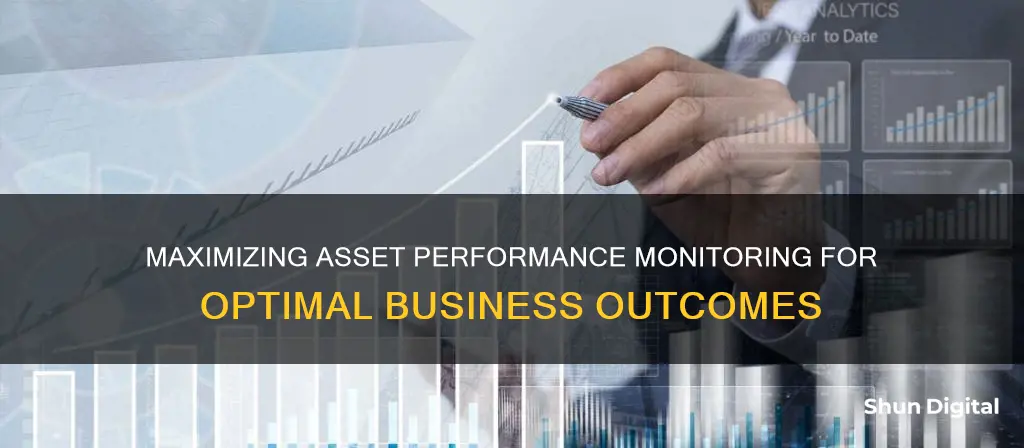
Asset performance monitoring (APM) is a strategic approach to managing assets that companies use to optimise the performance of their most valuable assets, including buildings, equipment, vehicles, software and technology. APM is a unified strategy that assists people, processes and systems to work together towards sustained operational excellence. APM encompasses the capabilities of data capture, integration, visualisation and analytics tied together for the explicit purpose of improving the reliability and availability of physical assets. APM includes the concepts of condition monitoring, predictive forecasting and reliability-centred maintenance.
| Characteristics | Values |
|---|---|
| Purpose | To monitor, assess, maintain, and fund the equipment (assets) that are needed to run a business |
| Scope | Monitoring how an asset performs during operations |
| Data | Energy usage, uptime, output performance, CPU usage, storage capacity, network connectivity |
| Benefits | Optimized performance of assets, reduced downtime, improved reliability, reduced maintenance costs, improved operational efficiency |
| Techniques | Strategic monitoring, performance measures and targets, system audits, compliance monitoring, predictive maintenance, AI-enhanced analytics, remote monitoring |
What You'll Learn

Tracking energy usage
Recent developments in technology, such as sensorisation and the industrial internet of things (IIoT), have enhanced the ability to track energy usage with unprecedented clarity. These advancements allow for the collection of critical data, which can be uploaded to a database or stored in the cloud.
Additionally, asset performance monitoring software plays a crucial role in tracking energy usage. Software solutions provide plant operators with access to data collected from assets, enabling them to make informed decisions. Visualisation tools and analytics further enhance the understanding of energy usage data, allowing for the identification of patterns and optimisation of energy efficiency.
Furthermore, tracking energy usage at a granular level is possible through the use of electricity usage monitors. These devices can be plugged into outlets, allowing users to measure the energy consumption of specific devices or appliances. This level of detail helps identify "vampire energy" leaks, where devices in standby mode continue to draw power.
By effectively tracking energy usage, organisations can reduce costs, improve operational efficiency, and make more informed decisions about their assets.
Choosing the Right-Sized Monitor for Your iMac Pro
You may want to see also

Preventing equipment failure
One way to prevent equipment failure is to use asset performance management (APM) software. APM software focuses on connecting disparate data sources and using advanced analytic techniques to turn data into actionable insights. For example, APM software can help organisations to identify, mitigate, and prevent equipment failures and system disruptions before they occur. By collecting performance data via sensors, engineers can then apply proprietary algorithms to predict and prevent equipment failures. APM software can also be used to monitor key health indicators and determine asset health and predictive maintenance requirements, allowing for more detailed monitoring of entire processes.
Another way to prevent equipment failure is to use reliability-centred maintenance (RCM) concepts. RCM focuses on critical equipment or production bottlenecks, as failures in these assets can lead to greater damage compared to auxiliary equipment. By investing in preventive machine maintenance, organisations can achieve sustainable production continuity and increase equipment availability.
Additionally, online condition monitoring is a proactive approach to industrial maintenance that utilises high-tech sensors to monitor variables such as vibration and temperature. This allows for interventions to be made before failures occur, contributing to the optimisation of industrial machinery, increased efficiency, cost reductions, and higher availability and reliability.
Furthermore, the use of digital twins can assist in preventing equipment failure. A digital twin is a virtual representation of an asset that allows operators to run tests and predict performance based on simulations. This can help operators to spot performance issues and gain insights into possible improvements to maintenance plans.
By utilising these strategies and technologies, organisations can effectively prevent equipment failure, reduce costs, and increase operational efficiency.
Connecting an External Monitor to Your Surface Pro 4
You may want to see also

Reducing maintenance costs
Asset Performance Monitoring (APM) is a strategic approach to managing assets that companies use in their daily business operations. APM helps organisations reduce maintenance costs in several ways:
Preventative and Predictive Maintenance
APM solutions enable organisations to move from reactive, break-fix maintenance to preventative and predictive maintenance. Preventative maintenance is planned based on best practices and historical averages, such as the mean time between failures (MTBF). Predictive maintenance uses sensors to collect real-time data about an asset's condition, feeding this into AI-enabled software to predict when equipment issues may arise. By predicting and preventing equipment breakdowns, organisations can reduce costly unplanned maintenance and minimise downtime.
Improved Decision-Making
APM solutions provide data and insights that enable better decision-making around maintenance. By monitoring the health and performance of assets in real-time, organisations can avoid performing excessive or unnecessary maintenance.
Optimised Maintenance Strategies
APM solutions enable organisations to identify the optimal maintenance strategy for each asset. For example, some assets may follow a run-to-fail model, where failure is unlikely or easily fixed. For other assets, a fixed-time or cycle interval maintenance strategy may be appropriate. APM solutions can also support more advanced maintenance strategies such as condition-based, predictive, and prescriptive maintenance.
Increased Asset Longevity
By optimising maintenance activities and reducing the likelihood of equipment failures, APM solutions can extend the lifespan of assets. This reduces the need for costly asset replacements.
Improved Efficiency
APM solutions enable organisations to optimise their maintenance processes, improving efficiency and reducing the time and resources required for maintenance activities. For example, APM solutions can provide remote monitoring capabilities, reducing the need for on-site inspections.
Ankle Monitor: Strategies for Comfortable Sleep
You may want to see also

Remote monitoring
By leveraging digital technologies such as the Industrial Internet of Things (IIoT), organisations can collect and analyse data from remote assets. This data includes energy usage, throughput, CPU usage, storage capacity, and network connectivity. With advanced analytics, organisations can gain valuable insights into the performance and health of their remote assets, enabling them to make data-driven decisions and optimise their operations.
For example, remote monitoring can provide early warning signs of potential equipment failures, allowing organisations to take proactive maintenance actions and reduce unplanned downtime. This not only improves operational efficiency but also helps to extend the lifespan of assets and reduce maintenance costs.
Additionally, remote monitoring enables organisations to centralise the management of their remote assets. Through the use of cloud-based platforms and mobile applications, personnel can access critical information and make informed decisions from anywhere in the world. This enhances collaboration and knowledge-sharing across the organisation, fostering a continuous improvement culture.
Furthermore, remote monitoring supports the concept of condition-based maintenance, where maintenance activities are scheduled based on the actual condition of the asset rather than predetermined intervals. This approach eliminates unnecessary maintenance tasks, further optimising costs and improving the overall availability and reliability of the assets.
By embracing remote monitoring as a key component of their asset performance monitoring strategy, organisations can enhance their operational efficiency, reduce costs, and improve the overall performance and longevity of their remote assets.
Choosing the Right Monitor: Size Considerations for Your Setup
You may want to see also

Predictive maintenance
In the context of asset performance monitoring, predictive maintenance offers several benefits. Firstly, it increases asset efficiency by providing continuous monitoring and analysis of asset performance. Through the use of AI-powered anomaly detection, organizations can detect impending failures that might otherwise go unnoticed. This helps businesses save time, improve productivity, and make more accurate forecasts about asset health.
Secondly, predictive maintenance optimizes maintenance schedules by allowing organizations to plan maintenance checks at the right time. By analyzing real-time data from machine operations, companies can generate individualized predictions of impending issues and schedule maintenance accordingly. This proactive approach reduces the likelihood of unexpected breakdowns and helps maintain equipment reliability.
Additionally, predictive maintenance plays a crucial role in boosting production output and customer satisfaction. By minimizing unexpected asset failures and unplanned outages, businesses can focus on increasing productivity and enhancing customer satisfaction. With predictive maintenance, companies can make quick decisions, provide reliable alternative options during disruptions, and improve their overall communication with customers.
Furthermore, predictive maintenance contributes to reducing operation and maintenance costs. By targeting energy efficiency and providing routine diagnostics, organizations can identify future breakdowns in advance and make necessary adjustments. This not only saves energy but also helps avoid costly emergency repairs and reduces overall maintenance expenses.
Overall, predictive maintenance is a powerful tool in the realm of asset performance monitoring. By utilizing data intelligence and advanced technologies, organizations can improve asset efficiency, optimize maintenance schedules, enhance customer satisfaction, and reduce operational costs. This proactive approach to maintenance ensures that assets are well-maintained, reliable, and productive throughout their lifespan.
Hooking Stage Monitors to a Presonus Digital Soundboard
You may want to see also
Frequently asked questions
Asset performance monitoring is a key component of reliability management in any organization or enterprise that relies on physical production assets. It involves tracking the performance, health, and status of assets during operations. This can include buildings, equipment, vehicles, software, and technology.
Asset performance monitoring uses automated tools and sensors to collect data about asset performance, identifying anomalies, and generating alerts. This data can include energy usage, throughput, uptime, and output performance.
Asset performance monitoring provides real-time information about the state of an asset, alerting operators to maintenance requirements and enabling more intelligent analysis of asset performance. It helps reduce downtime, increase reliability, and optimize performance.
Asset performance monitoring can be implemented through asset performance management (APM) software solutions, which connect disparate data sources and turn data into actionable insights. It also involves establishing processes and procedures for monitoring, measuring, and evaluating asset performance and compliance.







